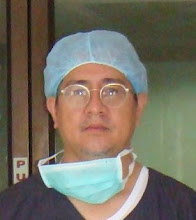Dr Halim wrote:
Split notochord syndrome
Split notochord syndrome(SNS)
Split notochord syndrome is a spectrum of congenital spinal malformations that develops due to an adhesion between endoderm and ectoderm causing the "splitting" of notochord due to a persistent connection between endoderm and dorsal ectoderm.
- Dorsal enteric fistula,
- dorsal sinus,
- dorsal diverticula and
- neurenteric cysts are the components of the spectrum
- Diastematomyelia
The SNS, as proposed by Bentley and Smith, (also known as posterior spina bifida, combined spina bifida, neurenteric fistula, dorsal enteric fistula) is an extremely rare form of dysraphism It was first described by Rembe in 1887. In this syndrome, vertebral anomalies (anterior and posterior spina bifida, butterfly vertebrae), central nervous system abnormalities (diastematomyelia, diplomyelia, myelomeningocele) and intestinal anomalies (fistulas, dermal sinus tract, diverticula and enteric cysts) are associated with each other.
The syndrome manifests as a cleft in the dorsal midline of the body through which intestinal segments are exteriorized (often with an associated fistula), myelomeningocele, and occasionally as a teratoma. Central nervous system abnormalities are always present: hydrocephalus and diastematomyelia/diplomyelia are constant findings. However, babies do not necessarily present with functional spinal cord defects: in some reported cases, the motor function of the lower limbs is normal. Talipes equinovarus is a common finding.
Diastematomyelia is a form of split notochord syndrome with sagittal division of the spinal cord into two pia-lined hemicords. In complete clefts with formation of two dural sacs, a fibrous, cartilaginous or osseous spur is present in half of the cases. The doubling of the cord can occur in the Thoracic regionAll forms of split notochord syndrome are frequently associated with vertebral anomalies such as anterior and posterior spina bifida, butterfly vertebrae and hemivertebrae
The embryologic mechanism for the development of split notochord syndrome was first discribed by Saunders in 1943 In the pathogenesis of split notochord syndrome, an adhesion occurs between endoderm and ectoderm in the route of notochord and notochord splits around the adhesion creating a defect in the vertebral column. Adhesion between endoderm and ectoderm also results in a potential connection between yolk sac (gut) and dorsal ectodermal surface (skin). This connection persists as a tractus in the dorsal enteric fistula, which is the most severe form of split notochord syndrome or may obliterate at any point creating a dorsal enteric sinus, diverticula and neurenteric cysts
The location of neurenteric cysts may be pre-vertebral, intraspinal or post-vertebral. The posterior mediastinum is a frequent location for pre-vertebral neurenteric cysts. Neurenteric cysts are lined by gastrointestinal or respiratory epithelium. Anterior and posterior spina bifida, butterfly vertebrae and hemivertebrae frequently accompany the neurenteric cysts . Prevertebral neurenteric cysts may be connected to the meninges or spinal cord by a tube or a fibrous neurenteric band via an anterior spina bifida and dura defect
NB
Picture taken from - www.scielo.br/.../jped/v80n1/en_80n1a15f01.gif

0 comments:
Post a Comment